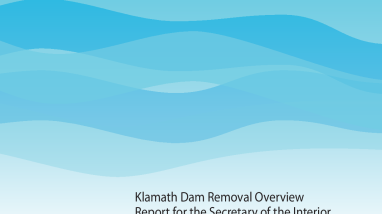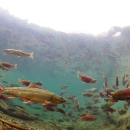The Klamath Basin covers over 12,000 square miles in southern Oregon and northern California and contains natural resources and economic opportunities related to fisheries, farming, ranching, hydroelectric power, timber harvest, mining, and recreation. These resources and opportunities have economically sustained many communities throughout the basin for decades. But development of these resources has not been without problems. For example, construction of PacifiCorp’s hydroelectric dams has blocked fish passage fish passage
Fish passage is the ability of fish or other aquatic species to move freely throughout their life to find food, reproduce, and complete their natural migration cycles. Millions of barriers to fish passage across the country are fragmenting habitat and leading to species declines. The U.S. Fish and Wildlife Service's National Fish Passage Program is working to reconnect watersheds to benefit both wildlife and people.
Learn more about fish passage to the upper basin for nearly 100 years and these dams adversely affect downstream water quality and water temperatures. Large-scale development of agriculture and ranching operations has also affected water availability and water quality with impacts on fisheries and other resources; Reclamation’s Klamath Project is the largest irrigation project in the basin, serving up to 235,000 acres of farmland.
The Klamath Basin is also home to six Federally recognized Indian tribes who depend on many of these same natural resources to support their way of life and spiritual wellbeing, as they have for thousands of years. The basin’s natural resources, including abundant and reliable supplies of fish, clean water, and terrestrial plants and animals, are central to Indian cultural identity. The availability and quality of some of these critical natural resources have been adversely affected by development in the basin.
Although rich in natural resources, communities throughout the Klamath Basin have faced repeated hardships because of water shortages, degraded water-quality, troubled fisheries, and the need to conserve three fish species protected by the Federal Endangered Species Act (ESA), including threatened coho salmon, Lost River suckers, and shortnose suckers. These hardships have been most strongly felt by Indian tribes, commercial and recreational fishing communities, farmers, and ranchers, but they also affect the economy of the entire basin and surrounding areas, often creating deep conflicts among these communities. Crises in agricultural water availability and fish populations became particularly acute from 2001 to 2010, including water delivery curtailment to farms, a major salmon die off, and restricted ocean salmon fishing. These events prompted the development of the Klamath Hydroelectric Settlement Agreement (KHSA) and the Klamath Basin Restoration Agreement (KBRA). The KHSA would provide for the removal of the four lower dams on the Klamath River (herein called the Four Facilities), which are currently owned by PacifiCorp. The KBRA contains water and power programs in the upper basin, basin-wide fisheries restoration programs, and programs to assist local and tribal communities. The KHSA and KBRA were developed by a broad range of local, tribal, state, and Federal stakeholders to resolve water and fisheries issues and to reduce the likelihood of future hardships; both agreements were signed by representatives of over 40 basin stakeholder groups in February, 2010, in Salem, Oregon. PacifiCorp signed the KHSA because their license to operate the Four Facilities expired in 2006 and their assessment that dam removal under the KHSA provided superior cost and risk protections for PacifiCorp and its customers as compared to continuing on a path of relicensing the Four Facilities.
Signatories of the KHSA, with the exception of the Federal government and PacifiCorp, also signed the accompanying KBRA. The Federal government is not able to sign the KBRA until Congress passes Federal legislation authorizing the agreement. Implementation of the KBRA is also being evaluated in this Overview Report because the KBRA would be implemented if there is an Affirmative Secretarial Determination1 on the KHSA. While some elements of the KBRA may be implemented without an Affirmative Secretarial Determination, a number of the actions and programs described in the KBRA would likely not be implemented, or would be implemented differently, if the Secretarial Determination was negative, and the Four Facilities remained in place.
Publication date
Type of document
Report
Facility
Program
Species
FWS Focus
FWS Focus
FWS Focus
FWS Focus
FWS Focus
FWS Focus
FWS Focus
FWS Focus
FWS and DOI Region(s)






